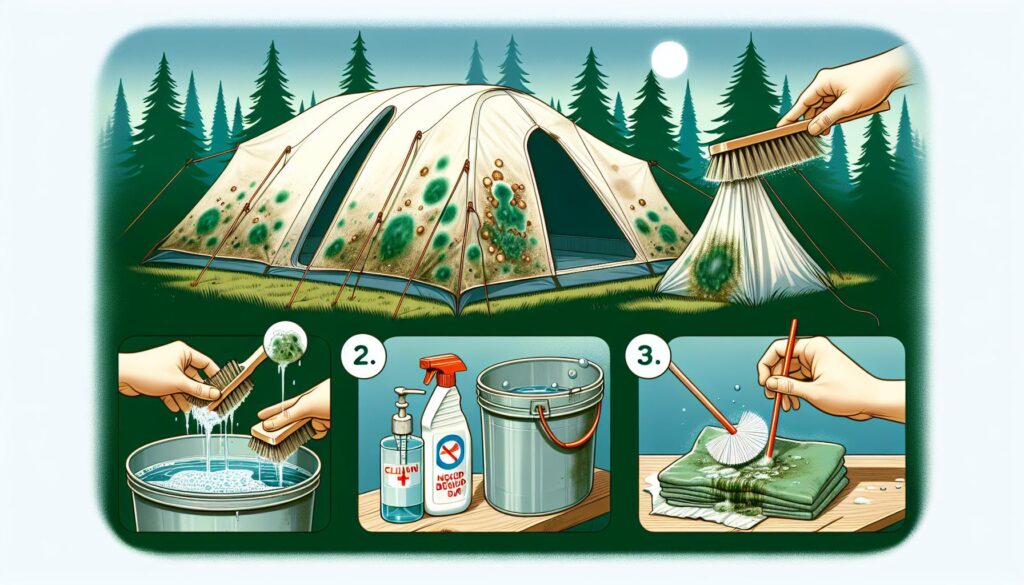Erasing mold from your tent involves a simple process of concocting a warm water and mild detergent solution and employ a soft scrub brush to tenderly eliminate the mold stains from the tent fabric. This fundamental guide will ensure that you restore your tent back to optimum condition in no time.
Investing in the maintenance and proper cleaning of your tent is crucial for enhancing its lifespan and guarantees a safe camping experience. Notably, there could be occasions when tents become a haven for mold, which damages its physical appearance and presents potential health hazards. Mold thrives best in damp and humid conditions, such as when you pack a wet tent or store it in areas that lack sufficient ventilation.
Any signs of mold on your tent must be remedied promptly. This comprehensive guide provides you with user-friendly steps to thoroughly clean your mold-infested tent, thereby restoring its initial freshness and cleanliness. Adhering to these steps not only eradicates the mold, but also aids in inhibiting its reoccurrence, empowering you to relish your next camping adventure without any hurdles.
Table of Contents
Relevance of Routine Tent Maintenance
Periodic tent maintenance is of paramount necessity to curb mold growth and ensure the longevity of your tent. This is not just pivotal for a relaxed and healthy camping experience, but it also contributes to cost savings in the longer run. Mold thrives in dark damp conditions, and tents are especially vulnerable to mold growth because of their habitual exposure to moisture. If your tent is discolored by mold, the first step is to set it up in an adequately ventilated area and dust off any loose dirt or debris. Proceed by concocting a solution of mild soap and water, and use a soft brush or sponge to gently scrub down the affected areas. Rinse thoroughly and allow the tent air dry in totality before packing it away. Consistently inspect and store your tent correctly to prevent the growth of mold and enhance its lifespan.
Spotting and Assessing Mold Growth in Your Tent
Identifying and Evaluating Mold Growth in Your Tent
When it comes to the task of cleaning a tent compromised with mold, the initial step involves identifying and assessing the severity of mold growth. Stay alert for visible indications of mold, such as dark or green spots on the fabric. These patches could have a fuzzy or slimy character, signaling the presence of mold. Furthermore, your sense of smell can play a vital role in this task- a musty odor emanating from the tent typically points to mold growth.
Once you have acknowledged the presence of mold, appraising its extension is extremely important. Examine the entire tent to discern how far has the mold spread. Make sure to probe all seams, corners, and concealed areas thoroughly. Bear in mind that mold can infiltrate profoundly into the fabric, hence an analysis restricted to the surface may not disclose the full extent of infestation. This evaluation is crucial for determining the suitable cleaning technique and ensuring effective mold removal.
Compiling the Right Tools and Supplies
Having the right tools and supplies in hand is significant to successfully clean a moldy tent. The list of items you’ll require include:
- Mold-removing cleaning agents and sprays
- Soft-bristled brush or sponge
- Vinegar, baking soda, and hydrogen peroxide
- Supplementary cleaning cloths or rags
Start your cleaning process by applying mold-removing cleaning compounds or sprays effectively. Their specific design is slated to tackle mold and mildew. Use a soft-bristled brush or sponge for gently scrubbing the troubled areas, making sure to cover every corner.
For stubborn mold stains, crafting your own natural cleaning solution by combining vinegar, baking soda, and hydrogen peroxide can work wonders. Apply this concoction to the mold-affected areas and let it rest for a few minutes, followed by a gentle scrubbing.
Upon successful removal of the mold, make a point to rinse the tent thoroughly with clean water. Employ the cleaning cloths or rags to dry the tent entirely before stowing it away.
A Comprehensive Guide on Mold Removal and Tent Cleaning
Exhaustive Guide for Mold Removal and Tent Cleaning
Thorough inspection and cleaning of the exterior of the tent is the first stride towards abolishing mold. Begin by putting up the tent and scrutinizing the outer surface for signs of mold growth. Use a soft-bristle brush or sponge drenched in a solution of mild detergent and water to gently scrub the affected areas. Rinse the tent comprehensively with clean water, ensuring the removal of all soap traces.
Next, your focus should shift to the rainfly and groundsheet. Detach them from the tent and lay them flat on a clean surface. Implement the same cleaning process for the rainfly as the tent exterior, taking extra care with the seams. For the groundsheet, a sponge or cloth can be used to rub off any persistent mold, dirt, or stains. Rinse both parts thoroughly and allow them to air-dry completely before storing them back into the tent.
Moving to the interior of the tent, ensure that all vents and zippers are open to facilitate air circulation. Employ a vacuum cleaner equipped with a brush attachment for the removal of loose dirt and debris. Prepare a solution of warm water mixed with baking soda or vinegar, and apply it to any mold-affected regions inside the tent using a sponge or cloth. Leave the solution on for a few minutes, followed by a thorough rinse with clean water and subsequent air-drying.
The tent poles and stakes are not to be neglected. Wipe them gently using a clean cloth or sponge dipped in a mild detergent solution mixed with water. Rinse these accessories thoroughly and let them dry out in their entirety before storing them away.
Adhering to these guidelines ensures that you can effectively clean a mold-infested tent and leave it clean, fresh, and ready for your next outdoor adventure.
Special Precautions for Cleaning Different Tent Materials
Eliminating mold and cleaning your tent calls for special attention depending on the type of material your tent is made of. For nylon tents, you initiate the process using a solution of warm water mixed with a mild detergent, followed by a thorough scrub using a soft brush or sponge. Rinthe tent attentively and let it dry completely before storage.
For canvas tents cleaning and maintenance, a mixture of vinegar and water is your best bet to get rid of mold. Apply the solution to mold-affected sections on the tent and scrub it down tenderly with a brush. It’s crucial to let the tent air dry in a well-ventilated area to ensure mold doesn’t reoccur due to residual moisture in the fabric.
Navigating Tent Maintenance: A Guide to Cleaning and Mold Removal
The key to effectively cleaning a moldy tent employs a simple formula: a mixture of warm water and mild detergent combined with a soft scrub brush to gently remove the stained and moldy tent fabric. This essential guideline will have your tent sparkling like new in no time at all.
Maintenance and regular clean-ups of your tent are paramount to maximizing its life-cycle and ensuring safe and memorable camping experiences. Occasionally, however, tents may fall prey to mold growth, affecting not just their aesthetics but also presenting considerable health issues. Damp and humid conditions provide the ideal environment for mold growth – conditions that arise when you pack away a wet tent or store it in a poorly ventilated space.
At the first signs of mold on your tent, it becomes critical to address it speedily. Our guide provides a straightforward step-by-step process to eradicate mold from a tent and restore its original freshness and cleanliness. Adherence to these steps will successfully eliminate the unsightly mold and prevent its resurgence, letting you embrace your next camping adventure completely worry-free.
Understanding the Importance of Routine Tent Maintenance
Regular maintenance of your tent is indispensable to mitigate mold growth and extend the lifespan of your tent. This not only ensures a comfortable and healthy camping experience but also brings long-term financial benefits. Tents are particularly vulnerable to mold growth owing to their frequent exposure to moisture in usually damp and dark conditions. When cleaning a tent with visible mold growth, the first step is to set it up in a well-aired area, brushing off any loose dirt or debris. Concoct a mixture of mild detergent and water, using a soft brush or sponge to gently clean affected areas. Rinse thoroughly and let the tent air out completely before packing it away. Regular inspection and proper storage of your tent can prevent any future mold growth and significantly extend its lifespan.
Spotting and Assessing Mold Growth in Your Tent
Detecting and Evaluating Mold Growth in Your Tent
The primary step in cleaning a mold-infested tent is to identify and assess the extent of mold propagation. Be vigilant of visible indications of mold, including black or green spots on the fabric, which may appear slimy or fuzzy, suggesting mold presence. Additionally, your sense of smell could play a critical part in mold detection, with the musty odor from the tent often a clear sign of mold growth.
After confirming the presence of mold, the next step is evaluating how far the mold has spread. Conduct a thorough examination of the entire tent, inspecting all seams, corners, and hidden sections. It’s worth noting that mold can penetrate deep into the fabric; hence, a preliminary inspection may not reveal the entire extent of the infestation. This evaluation is indispensable for choosing the appropriate cleaning methods, guaranteeing effective mold removal.
Gearing Up: Assembly of Necessary Tools and Supplies
Cleaning a mold-infested tent requires access to suitable tools and supplies. Here are some of the items you’ll need:
- Cleaning solutions and sprays specifically for mold removal
- Soft-bristled brush or sponge
- Vinegar, baking soda, and hydrogen peroxide
- Cleaning cloths or rags
Begin the cleaning process by liberally using the mold-removing cleaning solution or spray, which are specifically formulated to combat mold and mildew growth. Gently scrub the affected areas with a soft-bristled brush or sponge, ensuring every nook and cranny is addressed.
In the case of tenacious mold stains, you can prepare your own eco-friendly cleaning solution by mixing vinegar, baking soda, and hydrogen peroxide. Apply this homemade cleaner to affected zones, letting it sit for several minutes before initiating scrubbing.
Upon successful removal of mold, it’s crucial to ensure the tent is thoroughly rinsed with clear water. Use cleaning cloths or rags to completely dry the tent before packing it up for storage.
Cleaning in Action: A Step-by-Step Guide on Mold Removal and Tent Cleaning
A Detailed Guide to Mold Eradication and Tent Cleaning
The path to a mold-free tent begins with a detailed inspection and cleaning of the tent’s exterior. Start by setting up the tent and examining the outer surface for any sings of mold growth. Using a soft-bristle brush or sponge soaked in a blend of mild detergent and water, scrub infected areas gently. Rinse the tent with plenty of clean water to ensure removal of any soap remnants.
Moving on to the rainfly and groundsheet, detach them from the tent and lay them on a clean surface. Clean the rainfly following the same process as with the tent exterior, paying due diligence to the seams. For the groundsheet, utilize a sponge or cloth to rub off any mold, dirt, or stubborn stains. Thoroughly rinse both components, leaving them to thoroughly dry in a well-aired space before packing.
The next step is cleaning the
The Ultimate Guide on Removing Mold and Cleaning Your Tent for Epic Outdoor Adventures
Fretting over the mold on your tent? With warm water, mild detergent, and a scrub brush at your side, you can effortlessly wipe those pesky mold stains from the fabric of your tent.
Tent care is no mere accessory to your camping experience. It’s the fundamental prerequisite that ensures longevity of your invaluable gear, providing a safe and comfortable shelter in the heart of the wilderness. However, tents can inadvertently become breeding grounds for mold, affecting both their aesthetics and the health of the inhabitants. Mold tends to flourish in damp and humid conditions – conditions that your tent might be exposed to if you pack it away while it’s still wet or store it in an inadequately ventilated area.
When mold marks its presence on your tent, it’s crucial to take immediate action. We’ve created this guide that provides you with simple, hassle-free steps to clean a tent tainted by mold, and restore it to its original cleanliness and freshness. Adhering to these steps will not only rid your tent of the unsightly mold but it’ll also equip you with preventive measures to keep mold at bay. Now, you can look forward to your upcoming camping adventures sans any worries.
Why Regular Tent Maintenance Matters
Regular maintenance is key for warding off mold growth and lengthening the lifespan of your tent. It means clean, hygienic surroundings for your camping trips and it prevents unnecessary expenses in the long run. Molds prosper in humid, dark environments, and tents, due to their recurrent contact with moisture, are particularly vulnerable. To clean a moldy tent, pitch it in an airy area and brush off any loose dirt or debris. Blend a mild soap with water to prepare a cleaning solution. Using a soft brush or sponge, carefully cleanse affected areas. Rinse altogether and let the tent air dry in its entirety before stowing it away. Regular inspections and proper storage of your tent can deter mold growth and extend its lifespan.
Pinpointing and Assessing Mold Development in Your Tent
Recognizing Mold Growth in Your Tent
En route to purifying a moldy tent, your first task is to spot the mold and measure its severity. Be on the lookout for visible indicators of mold, such as black or green splotches on the fabric. These patches may seem furred or slimy, denoting the existence of mold. Additionally, trust your instincts – if a musty stench wafts from the tent, it could well signal the development of mold.
Upon recognizing the mold, it’s critical to examine its spread. Perform a comprehensive check of the entire tent to ascertain the advancement of the mold. Inspect all borders, corners, and concealed spots. Remember, mold can sink deep into the fabric, and a cursory examination might fail to reveal the full spread of the infestation. This inspection is fundamental in choosing the right cleaning methodology and assuring complete mold elimination.
Gearing Up with the Right Tools and Supplies
For a thorough tent cleanse, ensure you’ve got the right artillery in the form of cleaning tools and supplies. Here are some necessary items you’ll need:
- Cleaning solutions or sprays specifically designed for mold removal
- A soft-bristled brush or sponge
- A versatile cleaning team of vinegar, baking soda, and hydrogen peroxide
- Rags or cleaning cloths
You can either trust a commercially available mold-removing cleaning solution or prepare your own concoction at home. Use a soft-bristled brush or sponge to softly scrub away the mold, ensuring you reach every nook and corner.
Incidentally, molds can sometimes be a stubborn lot. For these persistent occupants, use a potent blend of vinegar, baking soda, and hydrogen peroxide. Dab this homemade mixture on the affected regions, let it sit for a while before initiating the scrubbing frenzy.
After successfully ousting the mold, don’t forget to give the tent a thorough rinse with clean water. Then pat the tent dry using cleaning cloths or rags and ensure it’s arid before folding it away in storage.
A Comprehensive Tutorial on Mold Eradication and Tent Cleanup
Your Ultimate Guide to Mold Removal and Tent Cleaning
The journey to a squeaky-clean tent commences with an expedited inspection and cleansing of the tent’s exterior. Pitch your tent and scrutinize the outer surface for signs of mold incursion. Use a gentle hand with a soft-bristle brush or sponge, soak it in a concoction of warm water and mild detergent, and cleanse the affected areas. Post-cleaning, rinse the tent profusely with clean water to wash away any soap remnants.
Brace yourself next for the thorough cleansing of the rainfly and the groundsheet. Disentangle them from the main tent and spread them out flat on a dirt-free surface. Employ the same cleansing process with the rainfly as you did with the tent exterior, with extra care showered on the seams. Wipe away the groundsheet off any mold, dirt, or stains using a sponge or cloth. Rinse and dry these elements individually under adequate sun and air before packing them up.
For the interior of your tent, start by opening all entry points to encourage better air circulation. Use a vacuum cleaner furnished with a brush attachment to dust off loose dirt and debris. Blend a solution of warm water, baking soda or vinegar, and generously daub it on the problem areas with a sponge or cloth. Leave it undisturbed for a few minutes before rinsing it clean with water and air-drying it.
T














